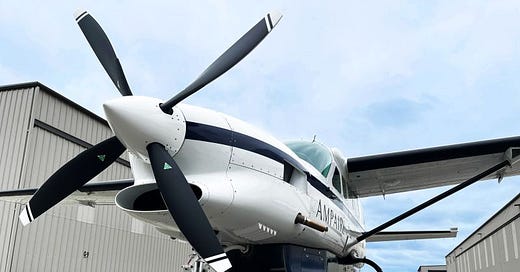We first invested in Ampaire in January 2023. Ampaire makes a hybrid powertrain for propeller-based aircraft. It has more power and range and burns less fuel than turboprop engines. The strategic move vis-à-vis the rest of the industry is that the system is designed to retrofit existing aircraft. They are the category leader and the furthest along the path.
I will share a little backstory here because it’s relevant to our conviction around Kevin and the company. David and I met Kevin Noertker at a Type One Ventures Space conference in LA. As we got to talking, he detailed how he had just walked away from an early exit offer. The upside was there, but the fit was off. We both noted this as it says something about the grit of an Entrepreneur.
Fast-forward another six months, and Kevin was raising additional capital for the business. The company had achieved an inflection point that fit our strategy, where they were turning LOIs into firm orders with deposits. This shift not only validated the market but also changed the revenue trajectory quickly. We invested in that round and have been big fans and supporters of Ampaire ever since.
What the FAA G-1 certification means and why it matters
The FAA G-1 program has 4 stages. Ampaire has now cleared the final and 4th stage of this process. The next stage is "G-2” and that sets the test criteria for final FAA certification for flight-worthiness.
No other hybrid-powertrain vendor has achieved the fourth stage of G-1 yet, a first for hybrid-electric propulsion. This is an important step for the entire industry.
The company remains on-track for a late 2026 full FAA approval for operation and is lining up 1st delivery for the same timeframe. This is notable when other sustainable aviation startups are pushing timelines, retrenching, and having to pivot to bring something viable to market.
Ampaire’s strategy keeps them ahead - ATR just announced they are pushing their project out to 2035, and their efficiency gains are in the 20-30% range. This is well below Ampaire’s AMP-H570 system. Other vendors like Vertical and Archer, who took the clean-sheet eVTOL approach, have now announced they, too, will build a hybrid powertrain system because pure electrification is too far out. If they started development yesterday, these systems are 5 years behind.
If you are interested in more detail, please read Revolution.Aero’s write-up here or check out Ampaire’s press release.
Congrats to Ampaire on this substantial milestone. We are looking forward to clearing G-2, which paves the way to commercial delivery of this industry-leading powertrain. The skies are about to get substantially more fuel-efficient and safer!




